SanDisk Extreme II Review (480GB, 240GB, 120GB)
by Anand Lal Shimpi on June 3, 2013 7:19 PM ESTAnandTech Storage Bench 2011
Two years ago we introduced our AnandTech Storage Bench, a suite of benchmarks that took traces of real OS/application usage and played them back in a repeatable manner. I assembled the traces myself out of frustration with the majority of what we have today in terms of SSD benchmarks.
Although the AnandTech Storage Bench tests did a good job of characterizing SSD performance, they weren't stressful enough. All of the tests performed less than 10GB of reads/writes and typically involved only 4GB of writes specifically. That's not even enough exceed the spare area on most SSDs. Most canned SSD benchmarks don't even come close to writing a single gigabyte of data, but that doesn't mean that simply writing 4GB is acceptable.
Originally I kept the benchmarks short enough that they wouldn't be a burden to run (~30 minutes) but long enough that they were representative of what a power user might do with their system.
Not too long ago I tweeted that I had created what I referred to as the Mother of All SSD Benchmarks (MOASB). Rather than only writing 4GB of data to the drive, this benchmark writes 106.32GB. It's the load you'd put on a drive after nearly two weeks of constant usage. And it takes a *long* time to run.
1) The MOASB, officially called AnandTech Storage Bench 2011 - Heavy Workload, mainly focuses on the times when your I/O activity is the highest. There is a lot of downloading and application installing that happens during the course of this test. My thinking was that it's during application installs, file copies, downloading and multitasking with all of this that you can really notice performance differences between drives.
2) I tried to cover as many bases as possible with the software I incorporated into this test. There's a lot of photo editing in Photoshop, HTML editing in Dreamweaver, web browsing, game playing/level loading (Starcraft II & WoW are both a part of the test) as well as general use stuff (application installing, virus scanning). I included a large amount of email downloading, document creation and editing as well. To top it all off I even use Visual Studio 2008 to build Chromium during the test.
The test has 2,168,893 read operations and 1,783,447 write operations. The IO breakdown is as follows:
| AnandTech Storage Bench 2011 - Heavy Workload IO Breakdown | ||||
| IO Size | % of Total | |||
| 4KB | 28% | |||
| 16KB | 10% | |||
| 32KB | 10% | |||
| 64KB | 4% | |||
Only 42% of all operations are sequential, the rest range from pseudo to fully random (with most falling in the pseudo-random category). Average queue depth is 4.625 IOs, with 59% of operations taking place in an IO queue of 1.
Many of you have asked for a better way to really characterize performance. Simply looking at IOPS doesn't really say much. As a result I'm going to be presenting Storage Bench 2011 data in a slightly different way. We'll have performance represented as Average MB/s, with higher numbers being better. At the same time I'll be reporting how long the SSD was busy while running this test. These disk busy graphs will show you exactly how much time was shaved off by using a faster drive vs. a slower one during the course of this test. Finally, I will also break out performance into reads, writes and combined. The reason I do this is to help balance out the fact that this test is unusually write intensive, which can often hide the benefits of a drive with good read performance.
There's also a new light workload for 2011. This is a far more reasonable, typical every day use case benchmark. Lots of web browsing, photo editing (but with a greater focus on photo consumption), video playback as well as some application installs and gaming. This test isn't nearly as write intensive as the MOASB but it's still multiple times more write intensive than what we were running in 2010.
As always I don't believe that these two benchmarks alone are enough to characterize the performance of a drive, but hopefully along with the rest of our tests they will help provide a better idea.
The testbed for Storage Bench 2011 has changed as well. We're now using a Sandy Bridge platform with full 6Gbps support for these tests.
AnandTech Storage Bench 2011 - Heavy Workload
We'll start out by looking at average data rate throughout our new heavy workload test:
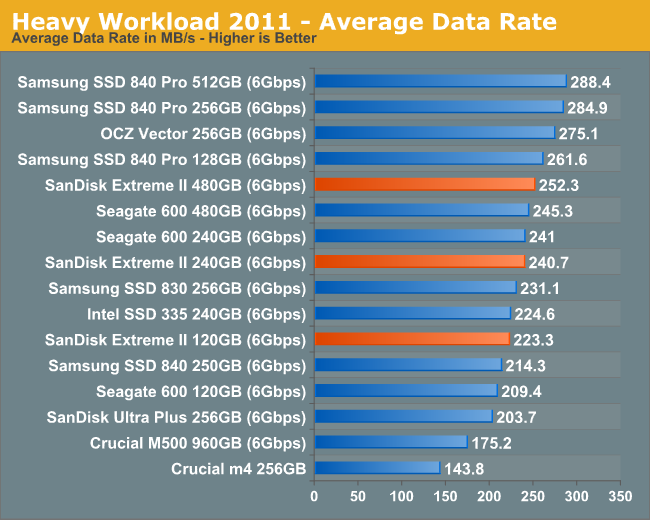
The Extreme II's peak performance isn't as good as the 840 Pro or OCZ Vector, but it's definitely very quick.
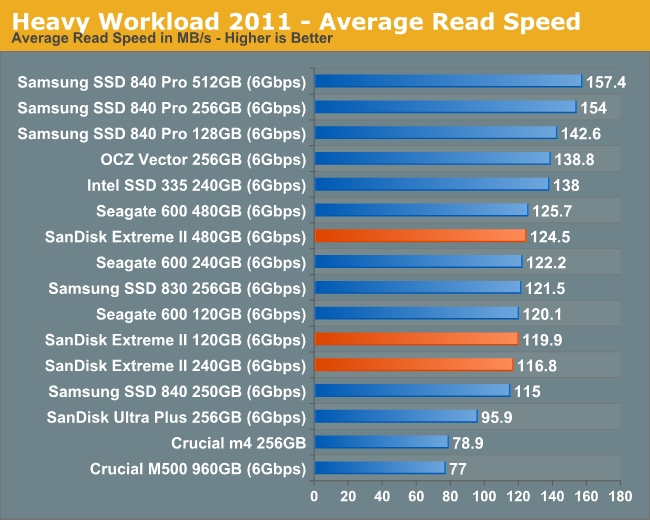

The next three charts just represent the same data, but in a different manner. Instead of looking at average data rate, we're looking at how long the disk was busy for during this entire test. Note that disk busy time excludes any and all idles, this is just how long the SSD was busy doing something:
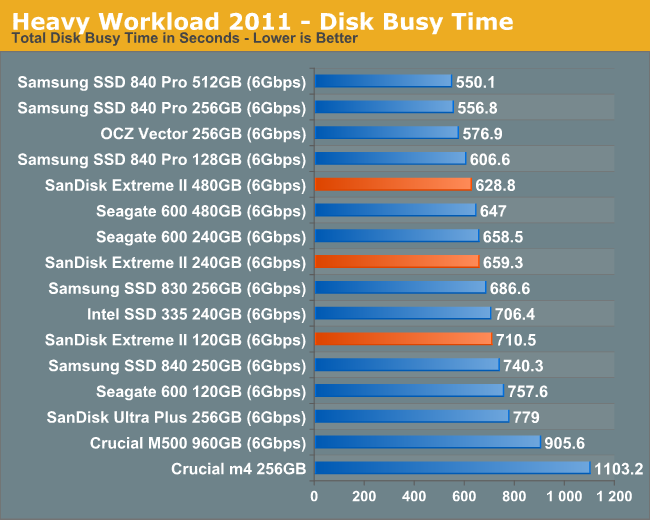
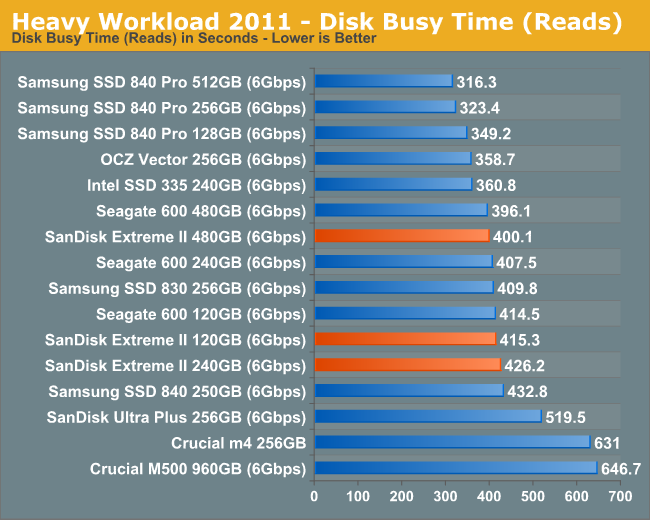
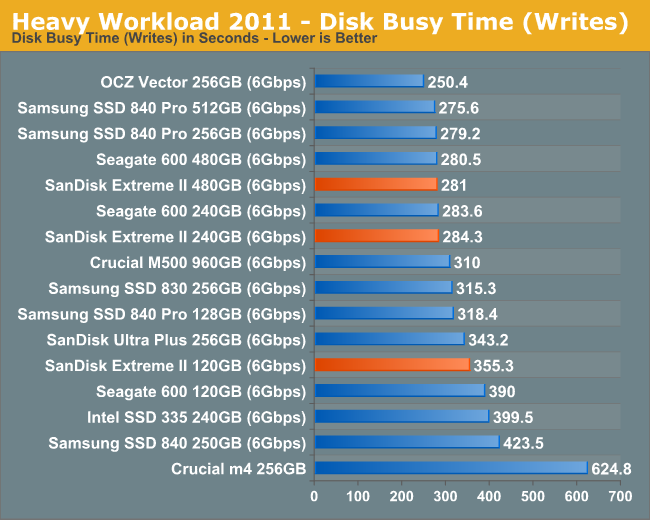










51 Comments
View All Comments
klmccaughey - Wednesday, June 5, 2013 - link
Hey, as one of these here "Coders" I can tell you my bread and butter is a ratio of 10:1 on thinking to coding ;) I suspect most programmers are similar.tipoo - Monday, June 3, 2013 - link
But in a sense Tukano is right, the SATA 3 standard can already be saturated by the fastest SSDs, so the connections between components are indeed the bottleneck. Most SSDs are still getting there, but the standard was saturated by the best almost as soon as it became widespread. They need a much bigger hop next time to leave some headroom.A5 - Monday, June 3, 2013 - link
The first round of SATA Express will give 16 Gbps for standard drives and up to 32 Gbps for mPCIe-style cards (used to be known as NGFF). I think we'll see a cool round of enthusiast drives once NGFF is finalized.althaz - Tuesday, June 4, 2013 - link
Storage is almost always the bottleneck. Faster storage = faster data moving around your PC's various subsystems. It's always better. You are certainly not likely to actually notice the incremental improvements from drive to the next, but it's important that these improvements are made, because you sure as hell WILL notice upgrading from something 5-6 generations different.What causes your PC to boot in 30 seconds is a combination of a lot of things, but seeing as mine boots in much closer to 5 seconds, I suspect you must be running a Windows 7 without a really fast SSD (I'm running 8 with an Intel 240Gb 520 series drive).
sna1970 - Tuesday, June 4, 2013 - link
not really.Storage is never a bottle neck . if you have enough memory , they will load once to the memory and thats it.
you need to eliminate the need to read the same data again thats all.
try to max your memory to 32G or 64 G , and make a 24G Ramdisk and install the application you want there. you will have instant running programs. there is no real bottlenecks.
kevith - Wednesday, June 5, 2013 - link
"Closer to 5 seconds".... From what point do you start counting...?seapeople - Wednesday, June 5, 2013 - link
Probably after he logs in.compvter - Friday, July 19, 2013 - link
5 seconds would be very fast, i get to windows desktop in w8 in 11 seconds. Calculated from pressing the power button on my laptop and stopped when i get to real desktop (not metro). I have older samsung 830 and first generation i7 cpu and 16gb memory.ickibar1234 - Friday, December 20, 2013 - link
After getting an SSD with a SATA 3 computer, it's mostly likely driver initialization, timers and stuff like that that is the bottleneck during bootup.Occas - Tuesday, June 4, 2013 - link
Regarding PC Boot time, easily for me it was my motherboard post time.My old Asus took minimum 20 seconds to post! When I bought my new system I researched post times and ended up with an ASRock which posts in about 5 seconds. Boom, now I can barely sit down before I'm ready to log in. :)